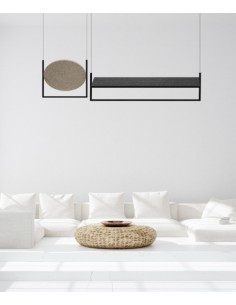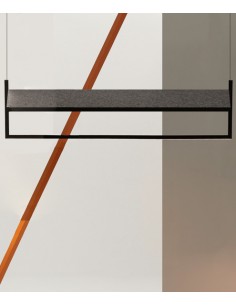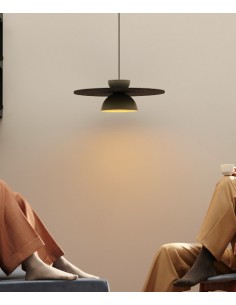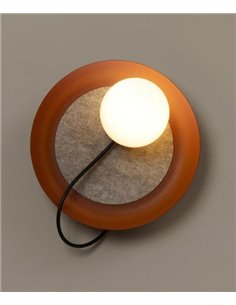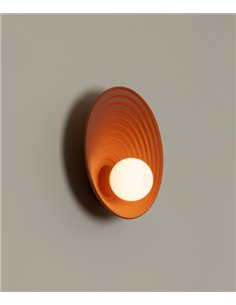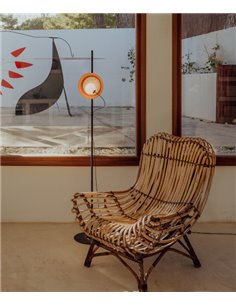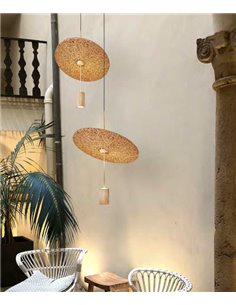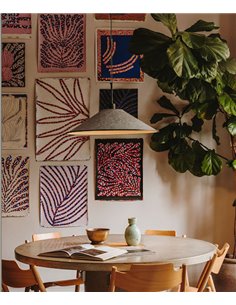Acoustic Lamps and Lights
Acoustic lights are the perfect combination of lighting efficiency and sound control, making them the ideal choice for environments requiring optimal acoustic ambiance. These lamps are equipped with sound-absorbing materials such as polyester fibres, acoustic foam, felt, or even wood. Furthermore, they are designed to provide ambient illumination while also reducing both echo and noise, significantly improving the environment's quality, especially in places such as offices, halls, or restaurants. With a variety of styles and sizes, acoustic lights adapt to any kind of decor, from the most modern to the most classic. Their LED technology not only guarantees high-quality lighting, sometimes adjustable according to needs, but also stands out for its energy efficiency. Most of these lamps are manufactured with recycled materials, plastics, or textiles, demonstrating a solid commitment to environmental sustainability. Their simple installation and minimal maintenance make these lamps a practical choice for both commercial and residential areas.
Are acoustic lights effective for reducing noise?
Yes, generally, these lights are a suitable solution for reducing annoying noise. Their design and materials are specifically aimed at improving the sound quality of spaces, making them increasingly popular in environments that require control over echo and noise. Their effectiveness can be attributed to several reasons:
- Sound-absorbing materials: the primary feature that minimizes sound and surrounding echo is the materials used, which include auditory felt, foam, polyester fibres, or wood, as they can absorb or diffuse sound. For example, auditory felt, and foam are known for their high efficiency in sound absorption.
- Acoustic considerations in design: the design of the light, including its shape and the arrangement of its materials, affects how it interacts with sound waves. Some lights are specifically designed to absorb sound, while others focus on direct absorption.
- Measurements of the lamp: size and coverage area also play a significant role. A larger light or an arrangement of multiple ones can offer better audible efficiency in larger areas.
- Nature of sound: this lamps may be more effective for certain types of noise or frequency ranges. Some are better at handling high-frequency sounds, such as voices, while others may be better at handling low-frequency sounds.
- Environmental factors: the audial efficiency of the light also depends on the environment in which it is used. Factors such as the existing sound conditions of the environment, the materials used for walls and ceilings, and the presence of other sound-absorbing elements affect the overall performance of the light.
On what materials are acoustic lights usually designed?
They are known for their innovative design, incorporating excellent aesthetics and sound-absorbing properties. These materials not only contribute to energy efficiency and lighting quality but also play a key role in improving the sound environment. The most common materials used include:
- Acoustic felt: This is the most commonly used material due to its sound-absorbing ability and versatility, as it can adapt to any design. Its smooth texture and range of colours make it suitable for both modern and traditional environments.
- Foam: Foam is a lightweight material that can be moulded into various shapes, allowing for unique designs that effectively absorb and dissipate sound, reducing environmental echo.
- Polyester fibres: These fibres are known for their durability and efficiency in sound absorption. Another significant advantage is their sustainability, as they are often made from recycled materials.
- Wood: When specially treated, wood not only adds a warm and natural touch to the decor but also effectively diffuses sound, improving the sound environment.
- Recycled materials: Many acoustic lamps are manufactured using recycled materials such as plastic and textiles, promoting sustainability while also offering excellent sound-absorbing properties.
The choice of these materials demonstrates a commitment to innovation and environmental responsibility, ensuring that these lamps not only effectively enhance the surrounding sound quality but also serve as aesthetically pleasing and sustainable products.
How much noise can an acoustic light absorb?
The exact amount of noise they can absorb varies depending on several factors, including its materials, design, and the dimensions of the area. It has been demonstrated that they effectively contribute to reducing reverberation and echo, creating a more comfortable and quieter environment.
For example, in an area where the background noise level is around 60 dB, introducing sound-absorbing lights could decrease this level by several decibels, resulting in a significant reduction in perceived noise. This reduction can improve speech clarity in offices or reduce auditory fatigue in public areas, fostering a calmer and more comfortable environment.
To achieve optimal results and maximise the sound-absorbing effect, it would be advisable to combine them with other noise control solutions. Furthermore, the larger and more densely filled with sound-absorbing materials the lamp's design is, the greater its capacity will be to enhance acoustic comfort in environments such as offices, homes, and recording booths, among others.
In what places are acoustic lights most needed?
They are ideal for environments requiring both high-quality lighting and effective sound control, are particularly essential in areas where noise could disrupt productivity, comfort, or the overall sound quality. Some of the places that benefit most from the installation of these lights include:
- Offices and workspaces: they help reduce background noise in work environments, especially in offices and coworking spaces, enhancing employees' concentration and productivity by minimizing distractions.
- Restaurants and cafeterias: these establishments aim to create cozy environments where customers can enjoy conversations without being overwhelmed by excessive noise, thus improving the dining experience.
- Hotels: assist in reducing noise in shared areas such as corridors, lobbies, restaurants, and bedrooms, ensuring guests enjoy a peaceful stay without disturbances from external or neighbouring room noise.
- Educational facilities: classrooms, libraries, and study areas benefit from the reduction of reverberation and echo, creating a conducive environment for learning and concentration.
- Shopping centres: ideal for shops, showrooms, and malls, where large crowds gather. By controlling sound, these lamps create a more comfortable environment for visitors.
- Health and wellness facilities: quiet environments are essential in surgeries, spas, and yoga centres for customer relaxation and well-being, with sound control playing a crucial role.
- Recording studios: acoustic clarity is paramount in these spaces, and these lamps help control echoes, optimizing sound quality during recordings.
- Homes: of course, they are also suitable for residential areas, significantly improving comfort by reducing unwanted noise.
